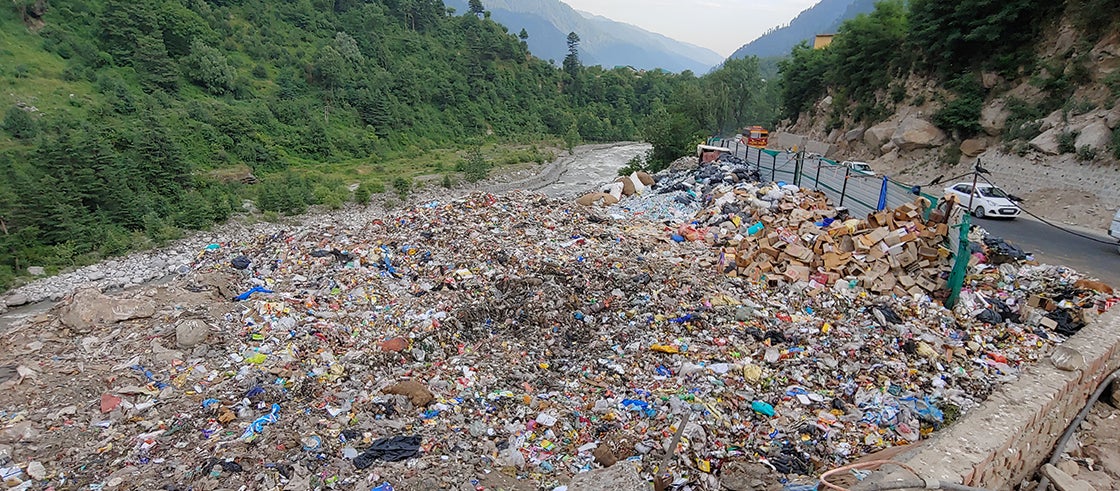 Dumpsite in Manali, Himachal Pradesh, India. Photo: Korea Environment Corporation
Dumpsite in Manali, Himachal Pradesh, India. Photo: Korea Environment Corporation
When one thinks of the Himalayas, a pristine picture of snow-capped mountain peaks, meandering streams, and green meadows dotted with coniferous trees comes to mind. The Himalayan region—spread across six countries covering an area of 595,000 square kilometers—is unquestionably a tourist and mountaineering haven . Tourism drives much of the local economy. It offers a respite for domestic tourists from the hot summers of the region, while also being an important destination for serious hikers and mountaineers.
WHAT ARE THE CHALLENGES?
With increasing urbanization and tourism in the Himalayas, there is growing concern around the sustainable management of solid waste. Litter along trails in tourist spots and open dumping of waste in valleys and streams have become common, which is also considered a huge public health and environmental pollution issue. The harsh climate, remoteness, limited land availability for waste treatment and disposal, and relatively weak infrastructure in the mountain landscape are some of the factors that make waste collection and safe disposal more challenging than in the urban lowlands.
The harsh climate, remoteness, limited land availability for waste treatment and disposal, and relatively weak infrastructure in the mountain landscape are some of the factors that make waste collection and safe disposal more challenging than in the urban lowland.
Another major challenge is the substantial data gap on the volume and types of waste being generated in settlements dotting the Himalayan landscape. The unique topography and climatic condition of the Himalayas—including urban hill towns, protected areas, and high-altitude and remote villages that are part of trekking routes—requires a special approach towards solid waste management (SWM). The World Bank, in collaboration with Korean Green Growth Trust Fund (KGGTF), embarked on a regional study to close the data gap and analyze the current SWM situation in the mountainous regions of India, Nepal, and Pakistan. The study also provides technical recommendations to promote sustainable SWM in the Himalayan region by helping these countries adopt a locally and regionally feasible landscape management approach.
Key Findings
Some of the key findings from data collected in the mountain areas of the three countries include:
Some of the key findings from data collected in the mountain areas of the three countries include:
- Municipal Solid Waste (MSW) generation: MSW generation varies depending on the level of urbanization, remoteness, volume of tourism, and income level of households in the mountain settlements.
- MSW composition: Biodegradable waste makes up a large fraction of mixed waste from sources such as households, markets, and hotels. Plastic is the main constituent of mixed waste in tourist hotspots.
- MSW segregation and collection: Accessibility is a key challenge due to difficult terrain, remoteness, and harsh climate and door-to-door waste collection is available to few households. With the exception of Nepal, almost no segregation of MSW is done in India and Pakistan.
- MSW disposal: Despite collection services being available in certain localities, waste is still disposed of indiscriminately in drains, ravines, valleys, streams, or rivers, and open burning of waste is a common practice.
- Willingness to pay: A majority of households are willing to pay for waste management services if the standard of services is efficient.
- Public awareness: Households consider waste management as intrinsic to environment health but lack awareness on current disposal practices and are unconcerned about disposal methods.
Way Forward
SWM issues are inter-connected to human and ecosystem health. At the same time, they have a tremendous impact on the tourism sector in mountain areas. The tourism sector also impacts the SWM sector, particularly in mountainous regions. Mismanagement of waste, such as open dumping and unsanitary landfill sites, does not only scar picturesque mountain landscapes, but can lead to land degradation, air pollution, and destabilize mountain slopes, among others. The waste thrown in rivers and streams often finds its way to downstream areas and finally into the oceans.
The waste thrown in rivers and streams often finds its way to downstream areas and finally into the oceans.
A key recommendation from the study is a systematic and phased approach aimed to improve SWM services in the mountainous regions of India, Nepal, and Pakistan. The approach in which the work is done in phases would be most suited as there are several activities related to SWM that are carried out simultaneously. A multi-tiered process ensures that the government and other partners are able to manage all of the moving pieces in waste management cycle, which includes institutional capacity, policy making, and enforcement, influencing behaviors of the waste producers, and improving technologies.
There is a need to improve data collection to understand the problems and bottlenecks specific to SWM in mountain areas. Several examples and good practices have been collected and synthesized to inform how mountain areas can improve SWM and restore their landscapes. For example, the Good Practice Options report shares, among 24 case studies, an integrated legislative, policy, and executive response of the Republic of Korea to establish their ambitious waste management hierarchy and how they transformed the Nanjido Island dump site to an eco-restoration park. The sustainable SWM program at the World Bank will continue to engage with client countries through webinars and other knowledge sharing platforms to redefine policies, infrastructure, and practices to improve collection and disposal of waste with an understanding of challenges of the mountain areas.
Related knowledge products are available by clicking on the following links:
- Infographic
- Story Map: Solid Waste Management in Mountain Areas. Challenges and Opportunities in India, Nepal, and Pakistan
Sustainable Solid Waste Management in Mountain Areas:







Join the Conversation